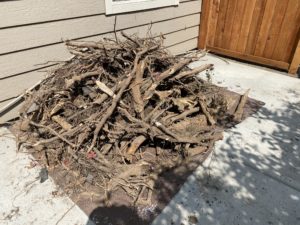We consulted several times with the homeowners about the scope of the project and about proceeding safely during COVID. We agreed to do a total remodel, which included demolition of all existing concrete, interior fencing, grass, plants and irrigation lines.
The rear fence, which backed up to a busy street was owned by the homeowner’s association, and therefore was to remain intact and not part of the project. There were a dozen mature trees and mature tall hedges, all with invasive root systems, within two feet or so of this rear fence. The homeowner agreed to hire an arborist to remove these trees and hedges. We cautioned them to be sure to have the arborist grind the stumps and remove all lateral roots as part of the tree removal.
We proposed that the project be divided into two phases, the first part being demolition. The two interior cross fences were to be removed in this phase, so as to allow access for the arborist and for the hauling service to remove all demolished material.
The second phase was to be installation of the new garden including patios, steps, new fencing, seat walls, masonry work, low voltage lighting, plants, lawn and irrigation.
We completed the demolition, arranged for the hauling, and moved on to another job while we waited for the arborist to complete their work, scheduled for over a month later.
Upon our return, we noticed that the trees and plants had been removed, the stumps ground, but the lateral roots had not been addressed at all. We indicated to the homeowner that all remaining lateral roots would have to be removed by us manually, at considerable expense. There was no way for us to reasonably estimate the cost of this root removal, since we could only see the network of smaller roots that had emerged on the surface beneath where the old lawn had been. The number, thickness and length of underground roots were hidden and anybody’s guess.
We built the two new cross fences, and continued with the second phase installation. As work proceeded, we removed roots as needed, piled them in a remote corner, and began keeping track of the time spent.
When we began excavating to plant new trees, we encountered some roots as large as six inches in diameter. As we are not arborists with heavy equipment – we were out of our element – and informed the homeowner. We recommended that they call the arborist back out and complete the root removal part of their original project. When they came back out and met with the homeowner we were not part of the conversation, but apparently they made some lame excuse about not having the equipment or capability to remove these roots.
Despite the specific exclusion of root removal in our contract with the homeowner, they held us responsible for arranging for this work to be done (at their expense).
Upon approval from the homeowner’s association to temporarily take down a section of the back fence, we arranged to rent a large excavator and hire an operator to get this work done, at the homeowner’s expense.
The sad part of this sad expensive tale, is that the arborist could have arranged for this root removal work to be done in the first place. Do it once, do it right.
